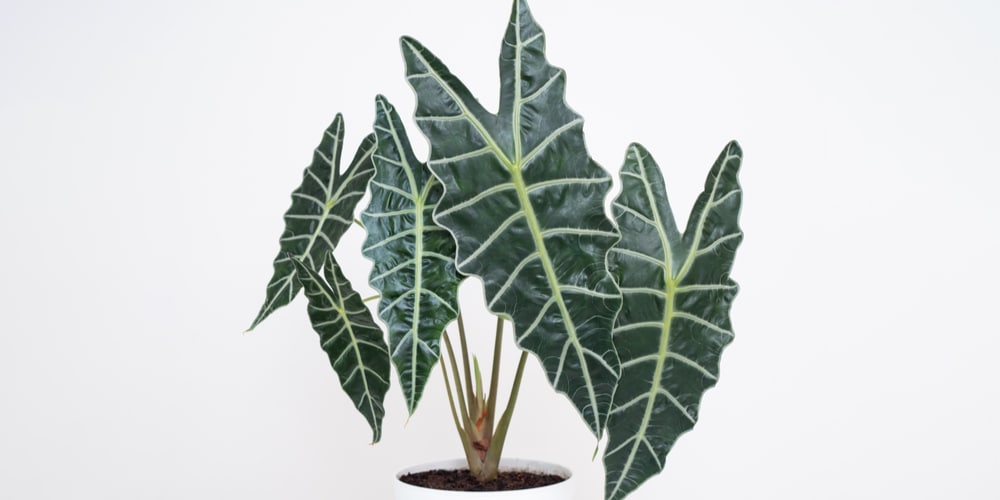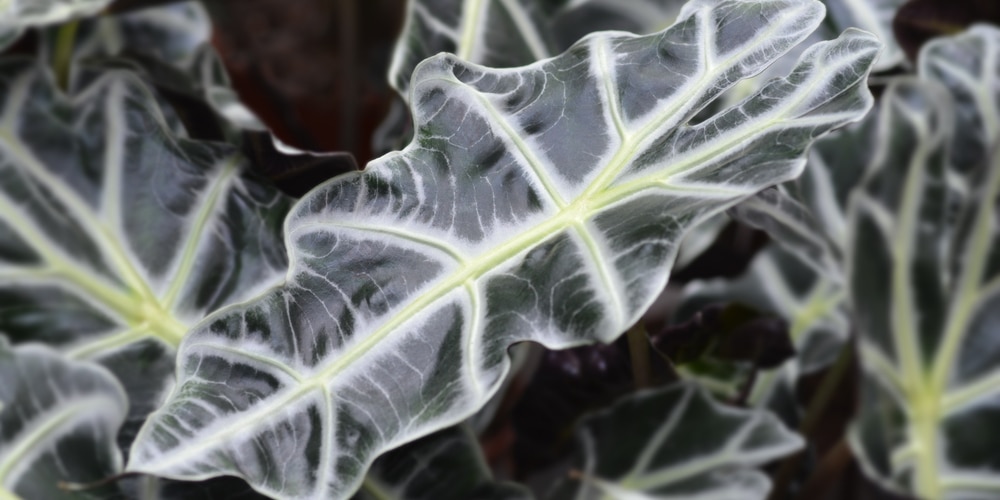The Alocasia Nebula plant is known as the Alocasia Polly, Elephant ear Polly or the African Mask plant. This attractive and popular tropical houseplant is an evergreen with unique triangle-shaped dark green leaves. The leaves have crinkly edges and light green veins. These plants also bloom with lovely flowers that are similar to calla lilies.
If you’re looking for an excellent houseplant that can be moved outside in the right climate, read on. This article will tell you all about the Alocasia Polly and give you tips about caring for the plant correctly.
What is the Alocasia Polly?
The Alocasia Polly is a unique house plant that is relatively easy to grow. It’s a hybrid variety that has been created by breeding the Alocasia watsoniana plant with the Alocasia sanderiana. These plants are popular with plant enthusiasts as they have lovely glossy leaves that are shaped like arrowheads. The leaves have silvery-green veins, and the plants can produce white flowers, which are similar to a peace Lilly.
The Alocasia Polly is a perennial plant that is fast-growing and reaches a height of 2 ft. at maturity. It spreads and can be propagated via a system of rhizome roots. Aloc
How to Care for the Alocasia Polly
Alocasia Polly, Nebula Plants are relatively easy to grow in the right conditions. They can be grown on a windowsill on a shelf in the corner of the room. Follow these tips which will help your plants to thrive:
Sunlight
The Alocasia Polly should be placed in bright indirect sunlight. You’ll need to protect your plant from the harsh sun as too much direct sunlight will cause the UV rays to scorch the plant’s leaves. Also, ensure that your plant isn’t constantly left in a shaded area, or the plant will stop growing, and its leaves will look dull or pale. It’s best to grow the Alocasia Polly on a windowsill where there is enough light.
Soil
Alocasia Polly plants do best in soil that’s well-draining and aerated. You can grow your plant in a regular houseplant soil that has either peat moss or perlite added. This soil mixture will be fertile and porous and will allow excess soil to drain away. You can also add some bark shavings, gravel, or charcoal to your plant’s pot to help with drainage.
Watering
The Alocasia Polly likes to be kept moist but should live in soggy soil as this can cause root rot. Water your plant regularly to keep the soil moist. It’s a good idea to feel the top inch of soil before watering. Wait until the topsoil has dried out between watering. Be careful not to overwater your plant, or it could die. Underwatering will cause the plant to wilt.
Temperature
Alocasia Polly plants love warm temperatures and should be kept at a temperature of between 65°F and 80°F. These plants are likely to stop growing and become dormant if the temperature falls below 60°F. The Alocasia Polly will drop its leaves if it gets too cold.
Humidity
Alocasia Polly plants thrive in high humidity, and household air is too dry for these plants. When kept in dry conditions, the plant’s leaves will become dry and crispy. It’s a good idea to mist your plants twice weekly with filtered water to keep them glossy and healthy. You may also like to invest in a humidifier or place plants close together to help improve humidity levels. Be careful not to make the leaves too moist as they can be prone to fungal growth or start to rot.
Fertilizer
Alocasia Polly plants can be fertilized once a month during the growing season. You can use a general houseplant fertilizer and dilute it to feed your plant.
Pruning
Alocasia Polly plants don’t need to be pruned. You can remove any leaves that are damaged or dead. Use pruning shears or scissors to snip off old leaves.
Pests
Alocasia Polly plants are prone to spider mite infestation. These tiny mites have eight legs and live in the soil or on the plant. They can be very difficult to spot and cause lots of damage to plants. They can also move onto other plants once they’ve killed or weakened your Alocasia Polly plant.
If you notice spider mites or any other insect on your plant, you can use a solution made from neem oil to get rid of pests. To make the solution:
- Mix two teaspoons of neam oil with a teaspoon of liquid dish soap and then add a liter of water.
- Put the solution into a spray bottle and then spray on your plant.
- Ensure that you spray both sides of the leaves.
Disease
The main disease that affects Alocasia Polly plants is root rot. When the plant’s roots become soggy due to overwatering, their roots will begin to rot, which will kill the plant eventually.
You can avoid root rot by watering your plants correctly. Don’t let the soil get too wet. You can also add stones or gravel to the bottom of the pot or mix peat moss into the soil to help with drainage.
Signs of root rot includes black patches on the plant’s leaves.
Toxicity
Unfortunately, Alocasia Polly plants are toxic to dogs and cats. If consumed, they can cause your pet to drool and vomit; you may also notice that your pet difficulty swallowing. Consult a vet if your pet has ingested this plant.
Alocasia Polly plants are also toxic to humans if ingested and can create a burning sensation around the mouth, which will result in blisters. The plant will also affect the mouth and throat, causing pain. Other symptoms include vomiting and diarrhea.
Keep this plant out of the reach of children and pets and seek medical attention as soon as possible if ingestion occurs.
Conclusion
Alocasia Polly plants have lovely foliage and make a great houseplant or plant for an office or waiting room. They can be grown on a windowsill and like warm, humid conditions. These plants flower in the right conditions but are mainly kept for their beautiful dark green foliage with light green or white veins. You may also enjoy Alocasia Regal Shield or Alocasia Lauterbachiana. Both of these plants are simmilar to the Nebula Plant and would look great in your home or office.

